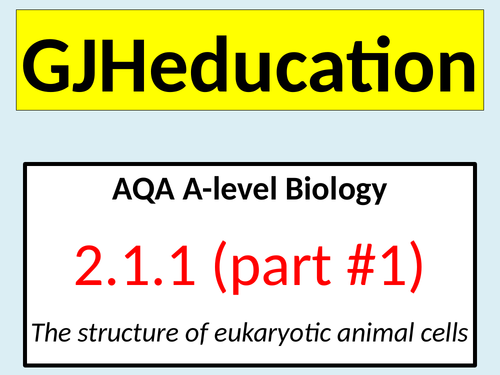












This fully-resourced lesson describes the relationship between the structure and function of the structures that are found in eukaryotic cells. The engaging and detailed PowerPoint and accompanying exam-question worksheets (which are all differentiated) have been designed to cover the first part of specification point 2.1.1 of the AQA A-level Biology specification and focuses on those structures found in animal cells. The additional structures, which are found in plant cells, are described in the next lesson uploaded under the title “Structure of eukaryotic (plant) cells”.
As cells are the building blocks of living organisms, it makes sense that they would be heavily involved in all of the 8 topics in the AQA course and intricate planning has ensured that these links to previously covered topics as well as upcoming ones are made throughout the lesson. A wide range of activities, that include exam-style questions, class discussion points and quick quiz competitions, will maintain motivation and engagement whilst covering the finer details of the following structures:
- nucleus
- nucleolus
- ribosomes
- rough endoplasmic reticulum
- Golgi apparatus
- lysosomes
- smooth endoplasmic reticulum
- mitochondria
- cell surface membrane
As mentioned above, all of the worksheets have been differentiated to support students of differing abilities whilst maintaining challenge
Due to the detail that is included in this lesson, it is estimated that it will take in excess of 3 hours of allocated A-level teaching time to cover the work
Get this resource as part of a bundle and save up to 31%
A bundle is a package of resources grouped together to teach a particular topic, or a series of lessons, in one place.
Topic 2: Cells (AQA A-level Biology)
This bundle contains 19 PowerPoint lessons which are highly-detailed and are fully-resourced with differentiated worksheets. Intricate planning means that the wide range of activities included in these lessons will engage and motivate the students, check on their current understanding and their ability to make links to previously covered topics and most importantly will deepen their understanding of the following specification points in topic 2 (Cells) of the AQA A-level Biology specification: * Structure and function of the organelles in eukaryotic cells * The specialised cells in complex, multicellular organisms * The structure of prokaryotic cells * The structure of viruses which are acellular and non-living * The principles and limitations of optical, transmission electron and scanning electron microscopes * Measuring the size of an object under an optical microscope * Use of the magnification formula * The behaviour of chromosomes during the stages of the cell cycle * Binary fission * The basic structure of cell membranes * The role of phospholipids, proteins, glycoproteins, glycolipids and cholesterol * Simple diffusion * Facilitated diffusion * Osmosis, explained in terms of water potential * The role of carrier proteins and the hydrolysis of ATP in active transport * Co-transport as illustrated by the absorption of sodium ions and glucose by the cells lining the mammalian ileum * Recognition of different cells by the immune system * The identification of pathogens from antigens * The phagocytosis of pathogens * The cellular response involving T lymphocytes * The humoral response involving the production of antibodies by plasma cells * The structure of an antibody * The roles of plasma cells and memory cells in the primary and secondary immune response * The use of vaccines to protect populations * The differences between active and passive immunity * The structure of the human immunodeficiency virus and its replication in helper T cells * How HIV causes the symptoms of AIDS * Why antibiotics are ineffective against viruses * The use of antibodies in the ELISA test If you would like to sample the quality of these lessons, then download the eukaryotic animal cells, viruses, microscopes, osmosis, lymphocytes, HIV and AIDS lessons as these have been shared for free.
Topic 2.1: Cell structure (AQA A-level Biology)
This bundle of 8 lesson PowerPoints and accompanying resources contain a wide variety of tasks which will engage and motivate the students whilst covering the details of topic 2.1 of the AQA A-level Biology specification. Cells and their structure are linked to all of the other 7 topics in this course so a clear understanding is critical to a student's success. The tasks which include exam-style questions (with displayed mark schemes), discussion points and quiz competitions will cover the following parts of topic 2.1: * The structure and function of the cell-surface membrane, nucleus, nucleolus, mitochondria, chloroplasts, Golgi apparatus, lysosomes, ribosomes, RER and SER, cell wall and cell vacuole * The specialised cells of complex, multicellular organisms * The structures of a typical prokaryotic cell * The differences between prokaryotic and eukaryotic cells * The structure of viruses * The principles and limitations of optical microscopes, transmission electron microscopes and scanning electron microscopes * Measuring the size of an object using an optical microscope * Using the magnification formula If you would like to sample the quality of these lessons, then download the eukaryotic animal cells, viruses and microscopes lessons as these have been uploaded for free
Something went wrong, please try again later.
Fantastic, interactive lesson.
Report this resourceto let us know if it violates our terms and conditions.
Our customer service team will review your report and will be in touch.